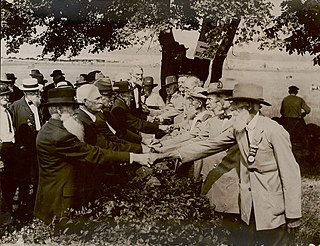 W
WThe 136th New York State Legislature, consisting of the New York State Senate and the New York State Assembly, met from January 1 to December 12, 1913, while William Sulzer, and then Martin H. Glynn, were Governor of New York, in Albany.
 W
WThe 1913 Great Meteor Procession occurred on February 9, 1913. It was a meteoric phenomenon reported from locations across Canada, the northeastern United States, and Bermuda, and from many ships at sea, including eight off Brazil, giving a total recorded ground track of over 11,000 km. The meteors were particularly unusual in that there was no apparent radiant, that is to say, no point in the sky from which the meteors appeared to originate. The observations were analysed in detail, later the same year, by the astronomer Clarence Chant, leading him to conclude that as all accounts were positioned along a great circle arc, the source had been a small, short-lived natural satellite of the Earth.
 W
WThe Federal Reserve Act was passed by the 63rd United States Congress and signed into law by President Woodrow Wilson on December 23, 1913. The law created the Federal Reserve System, the central banking system of the United States.
 W
WThe 1913 Gettysburg reunion was a Gettysburg Battlefield encampment of American Civil War veterans for the Battle of Gettysburg's 50th anniversary. The June 29–July 4 gathering of 53,407 veterans was the largest ever Civil War veteran reunion, and "never before in the world's history [had] so great a number of men so advanced in years been assembled under field conditions". All honorably discharged veterans in the Grand Army of the Republic and the United Confederate Veterans were invited, and veterans from 46 of the 48 states attended.
 W
WThe 1913 Liberty Head nickel is an American five-cent piece which was produced in extremely limited quantities unauthorized by the United States Mint, making it one of the best-known and most coveted rarities in American numismatics. In 1972, one specimen of the five cent coin became the first coin to sell for over US$100,000; in 1996, another specimen became the first to sell for over US$1 million. In 2003, one coin was sold for under three million dollars. In 2010, the Olsen piece sold for US$3.7 million at a public auction.
 W
WThe Model 1913 Cavalry Sword , commonly referred to as the Patton Saber, was a cavalry sword designed for the U.S. Army by Second Lieutenant George S. Patton in 1913. Patton suggested the revision from a curved sword and edge and cutting technique to a thrusting style of attack, following his extensive training in France.
 W
WThe National American Indian Memorial was a proposed monument to American Indians to be erected on a bluff overlooking the Narrows, the main entrance to New York Harbor. The major part of the memorial was to be a 165-foot-tall (50 m) statue of a representative American Indian warrior atop a substantial foundation building housing a museum of native cultures, similar in scale to, but higher than, the Statue of Liberty several miles to the north. Ground was broken to begin construction in 1913 but the project was never completed and no physical trace remains today.
 W
WThe Revenue Act of 1913, also known as the Underwood Tariff or the Underwood-Simmons Act, re-established a federal income tax in the United States and substantially lowered tariff rates. The act was sponsored by Representative Oscar Underwood, passed by the 63rd United States Congress, and signed into law by President Woodrow Wilson.
 W
WThe 1913 State of the Union Address was given by Woodrow Wilson, the 28th President of the United States, on Tuesday, December 2, 1913. It was given directly to the 63rd United States Congress by the president. Wilson was the first to do so since John Adams in 1800. With a few exceptions all addresses since then have been given directly following Wilson's lead.
 W
WThe presidency of Woodrow Wilson began on March 4, 1913 when Woodrow Wilson was inaugurated as President of the United States, and ended on March 4, 1921.
 W
WThe Woman Suffrage Procession, in 1913, was the first suffragist parade in Washington, D.C. It was also the first large, organized march on Washington for political purposes. The procession was organized by the suffragists Alice Paul and Lucy Burns for the National American Woman Suffrage Association (NAWSA). Planning for the event began in Washington in December 1912. The parade's purpose, stated in its official program, was to "march in a spirit of protest against the present political organization of society, from which women are excluded."